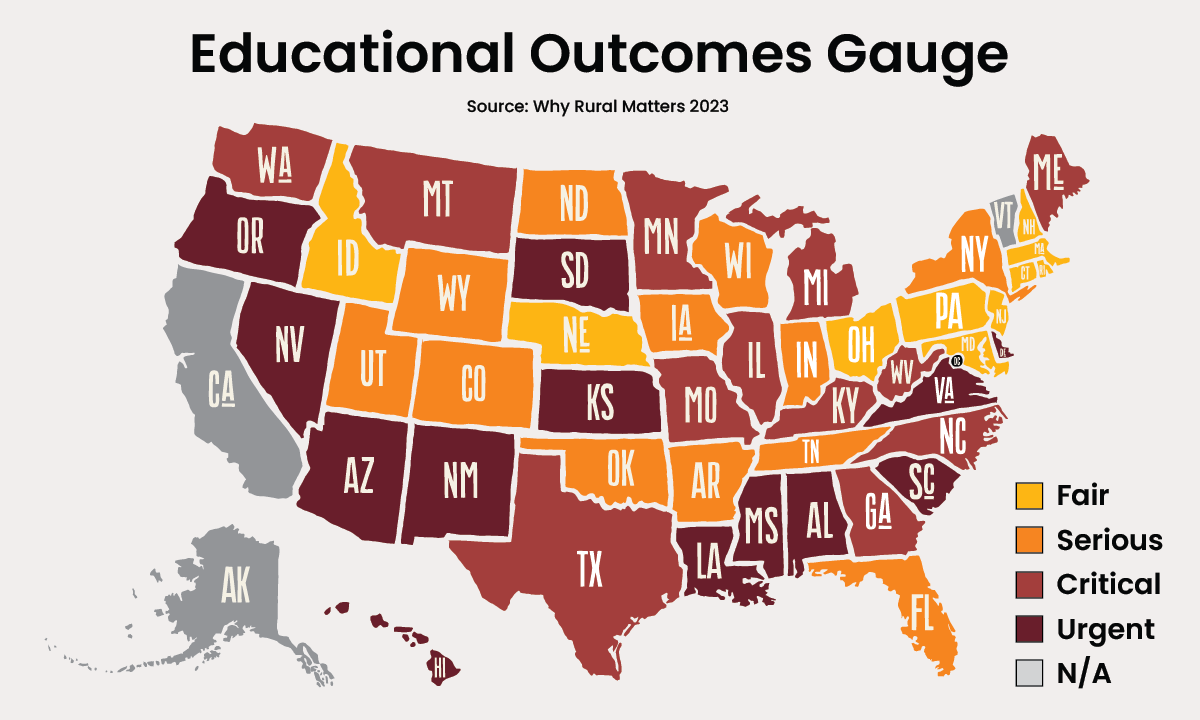New Report Shows Millions of Rural Students Facing Multiple Crises after COVID
Johnson & Pratt: Challenges from poverty and mental health to lack of internet and gifted programs are disrupting kids' educations & economic futures.

Get stories like these delivered straight to your inbox. Sign up for The 74 Newsletter
While the entire United States is still reeling in the wake of the COVID-19 pandemic, the recovery process has not been even nationwide. Many rural students and communities — especially certain pockets — are facing multiple crises in terms of educational loss, economic outcomes, unemployment and mental health.
Why Rural Matters 2023, the latest in a series of 10 research reports on rural education, shows that roughly 9.5 million students attend public schools in rural areas — more than 1 in 5 nationally. Nearly 1 in 7 of those rural students experience poverty, 1 in 15 lacks health insurance and 1 in 10 has changed residence in the previous 12 months.
Roughly half of all rural students live in just 10 states. Texas has the largest number, followed by North Carolina, Georgia, Ohio, Tennessee, New York, Pennsylvania, Indiana, Virginia and Michigan. Texas has more rural students than the 18 states with the fewest combined.
In 13 states, at least half of public schools are rural: South Dakota, Montana, Vermont, North Dakota, Maine, Alaska, Oklahoma, Nebraska, Wyoming, New Hampshire, West Virginia, Mississippi and Iowa. In 14 other states, at least one-third of all schools are rural.
More key findings from this edition of Why Rural Matters:
- More access to psychologists and guidance counselors is needed. In non-rural districts, there are an average of 295 students per guidance counselor or psychologist. In rural districts, the ratio increases to 310:1, with seven states (Minnesota, California, Mississippi, Alaska, Louisiana, Indiana and Michigan) having ratios worse than 400:1.
- More access to gifted and talented programs is needed for Black and Hispanic students in rural districts. Though 17% of students in rural schools identify as Hispanic, they represent only 9% of participants in these schools’ gifted programs. Similarly, 11% of the rural school population identifies as Black, but only 5% of the gifted student population in rural schools is Black. In contrast, 65% of rural students are white, as are 77% of participants in gifted programs.
- Rural areas appear to offset some of the impact of poverty on educational outcomes. Overall, students experiencing poverty scored 27 points lower than their peers on the grade 8 NAEP math assessment and 22 points lower in reading; in rural schools, these differences were 22 and 18, respectively. Socioeconomic equity in reading appeared to be highest within rural schools in Arizona, Idaho, Texas and Oklahoma, and most concerning in Illinois, Mississippi and Virginia. For math, the most equitable states were Hawaii, Arizona, West Virginia and Oklahoma; the least equitable states were Colorado and Louisiana.
- Many rural areas continue to lack basic internet access. The pandemic made clear that adequate internet connectivity is essential to equitable education opportunities. However, 13% of rural households lack minimum broadband connection for streaming educational videos or engaging with virtual classrooms. In six states, more than 1 in 6 rural households doesn’t have at least a basic broadband connection: New Mexico (21.4%), Mississippi (20.6%), Alabama (18.9%), West Virginia (17.5%), Arkansas (17.4%) and Louisiana (17.2%).
- Students in rural districts are more likely to graduate high school than their non-rural counterparts. In the majority of states with enough rural students to make data available, (34 of 46), rural students graduate at rates higher than their non-rural peers. Despite facing a range of spatial inequities, the unique strengths of rural areas —such as smaller schools and close community ties — combined to create graduation advantages of at least 5 percentage points in Nebraska, Connecticut, Maryland, Massachusetts, New York and Rhode Island.
- Many states provide a disproportionately larger share of school funding for rural districts because of the higher relative costs of running rural schools. Fourteen states, however, devote disproportionately less: Nebraska has the greatest disparity, followed by Vermont, Rhode Island, Iowa, Delaware, South Dakota, Michigan, Indiana, Wisconsin, Connecticut, Idaho, Illinois, Massachusetts and Minnesota.
- Rural school districts in Delaware, Oklahoma, North Carolina, and Nevada are the most racially diverse in the United States. In these states, two students chosen at random from a school in a rural district are more likely than not to be of a different race or ethnicity.
- Communities surrounding schools in rural districts on average have a household income of nearly three times the poverty line. Rates were lowest in New Mexico (1.85) and highest in Connecticut (5.32).
As post-pandemic recovery continues, states and local districts must reevaluate what it means to provide a public education that meets student and family needs and prepares young people for life beyond pre-K-12 schooling (including college and career readiness and engaged citizenship). These challenges are widespread but are most intense in the Southeast, Southwest and Appalachia. What is needed is the will to address them.
The results published in Why Rural Matters 2023 make clear that policymakers cannot ignore the difficulties faced by rural schools and the students they serve.
Get stories like these delivered straight to your inbox. Sign up for The 74 Newsletter

